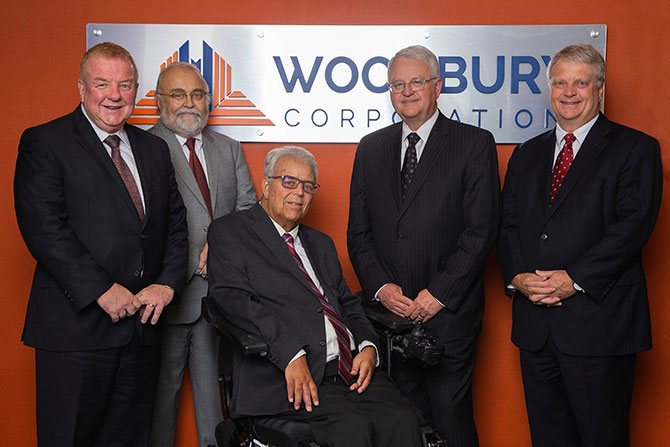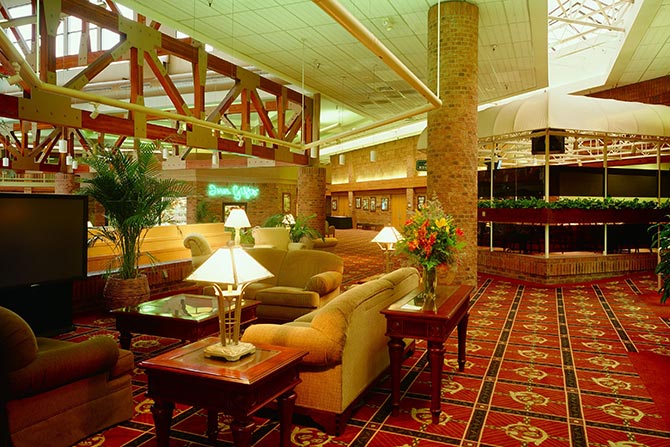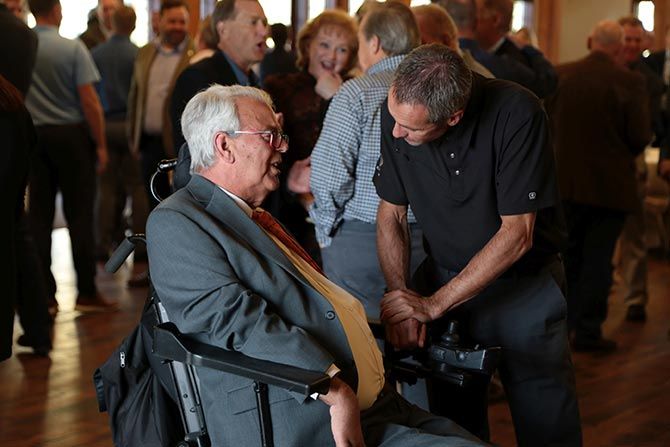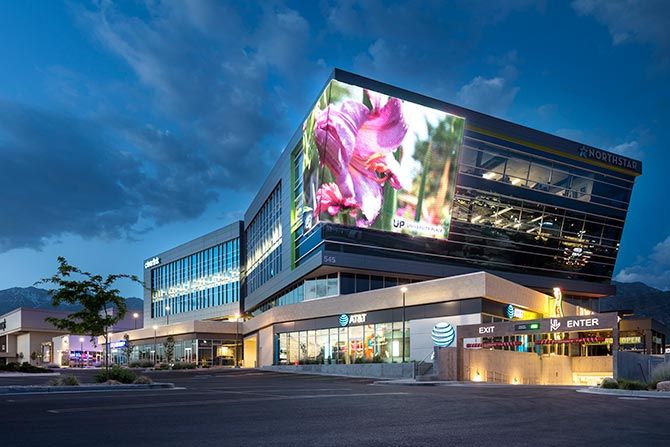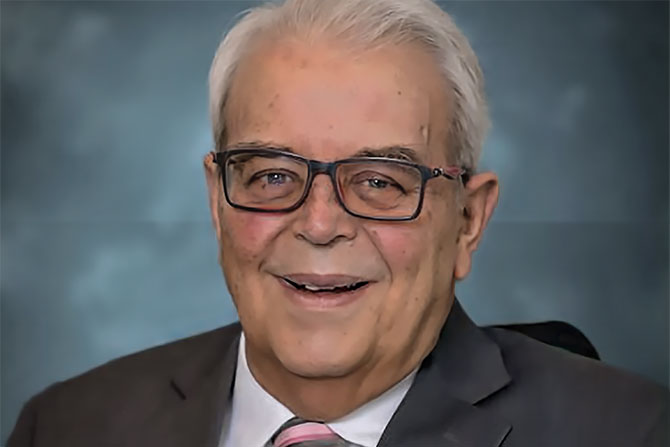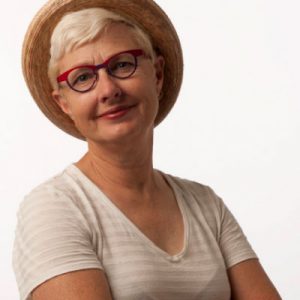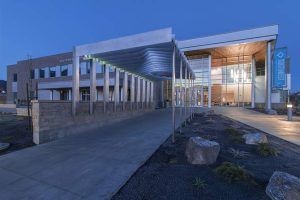Lynn Woodbury was on my list to interview for a long time for this series on AIA Utah Legends. He was active for decades in the industry and in the development sector, which is an unusual path for a licensed architect. He was an inspiration to many who admired his facility to be productive and creative after a life-altering injury. We talked and set up times for the interview, but time just got the better of us, and Lynn passed away on March 27, 2023.
Lynn Woodbury was born on June 24, 1952, in Salt Lake City, Utah, to Wallace Richards Woodbury and Beverley Clair Beesley. Lynn spent his youth golfing, creating mischief with “the boys” (lifelong friends), and he was an East High champion swimmer. Lynn joined the family firm — the Woodbury Corporation — first when he was in high school as a drafter. Woodbury is a development and management business that has thrived for over 100 years. The firm has a diverse portfolio that includes retail, office, hotel, multi-family housing, senior living, student housing and mixed-use projects.
Following a year working in the National Guard and a two-year mission for The Church of Jesus Christ of Latter-day Saints in Mexico City, Mexico, Lynn pursued his business degree and Master of Architecture at the University of Utah. He continued working with Woodbury during his college years and grew to play a critical role in the business, leading the design and construction division.
I talked with Lynn’s brothers, Jeff and Rick Woodbury, who worked with him in the business, about his career, his talents, his dedication and his legacy.
When did Lynn decide to become an architect?
Jeff: He got his drafting table when we split rooms in 1962; he was very young. He was always drawing house plans, swimming pools, site plans and layouts of buildings … he had all kinds of ideas about how he would do things. He moved into what was called the Pine Room, and my father bought him a drawing desk, got him a T square and rulers and different stencils, etc. to help him with his drawing.
Rick: I recall that he made his definite decision when he was 13 years old. I was two years older than he was. We were goofing around, and he was drawing up something and he said something like, “You know, Rick, I really want to become an architect.” I said, “Great, you do the architecture and engineering, I’ll do the law and business. Then we’ll do real estate.” That day in 1965, I think Lynn and I decided we’d go into business together.
What about his training?
Jeff: Lynn acted as a draftsman part-time from high school on, drawing out space plans and things like that. My father worked really closely with architects in-house on various buildings. We had an in-house architect by the name of Ben Grajalva. Lynn started working with the architect to help get our father’s ideas on paper.
Rick: Lynn asked my father if he could do some of that, and my father went to Ben and Ben was fine with it.
Jeff: Ben would give him little assignments. In the real estate business, you get a piece of land, or you get a building, and you pencil the concept. Then you give it to the architects to draw that up. We were all exposed to that type of activity from a really young age. Lynn was just more proficient at it than the rest of us and, in many ways, was a lot more thoughtful in the detail of his work.
Rick: He also did leasing and a lot of other things, not just architecture. He was an assistant to my father; he got a lot of business background. He told me in architectural school the criticism that his professors had of him was that he had to release his creativity, that he was too practical. His answer to his professors was, “Look, I’m trying to design projects that I know what will be built, so many of these other guys just design things that could never happen.” The professor said, “That’s fine, but you need to not worry so much about what can be built.” He got that idea working in the family business during high school and college, even before he got started working on an architectural degree. However, I think he did learn to use his creativity.
Jeff: The original concepts of our office were done when he was in architecture school. My father felt the concept designs were not great concepts — but over time, my father became converted. Ultimately, what we built is what Lynn designed, with some modifications.
Rick: When he got his architectural degree at the University of Utah then the question was, “Where does he apprentice?” In those days, you had to work a certain number of years under an architect in order to qualify to get your license. Ben was gone by then, but Dad and I hired Rich Dames and Vern Bush and absorbed that little firm with the understanding that they would do Woodbury projects, but also, that they would teach Lynn and he could apprentice under them. It might have been smarter to send him out to another architectural firm, but we were small. We felt like we needed him, and he wanted to stay with the business.
What type of projects did he work on?
Jeff: Residential, office, hotels, a lot of retail, medical, industrial – Lynn was involved in every type of project we did. He had a unique way of thinking three-dimensionally. He had a vision of how even complicated sites and complicated projects could happen. Most of Woodbury projects are built for tenants and companies; we don’t do a lot of spec space. Up until even a few months ago, Lynn had a way of coming up with an initial concept on a site that was very practical, very economical, very insightful. Even though he couldn’t draw in his later years, he was instructing other people to draw his vision. Lynn would save us a lot of money just because he could see by looking at the topo map and looking at the site how he could balance a site. That vision is really the talent that made him so valuable throughout his career, both before and after the accident.
Did he do the detailing as well?
Rick: In the early years, he did a lot of the detailing. He worked with Fred Babcock on the Holiday Inn in St. George, which was a fairly extensive project. And he did so much of the detailing that after the project was essentially completed, I went to him and said, “Lynn, we need you more on supervision and we need to hire other people to do that.” And it was a week later that he had his accident and kind of was forced into that anyway. But he’d always check the details throughout his career.
Jeff: Yes, of course, but the problem was we became too big. Ultimately, he was head of our construction and design department, and he had a series of architects and draftsmen underneath him. We did many projects where we did all the plans in-house. Then we did other projects where we hired an outside architecture firm, and there’d be a weekly, or a couple design meetings a week, on projects, and Lynn would be involved in those meetings. But as head of that department, he would also manage construction management. An architect is very important as a project is being built to make sure that the plans are being interpreted correctly by the contractor. I’ve had multiple contractors say he saw things that they didn’t see.
Can we talk about his accident, and how that changed his trajectory?
Jeff: The accident occurred on a trampoline at his sister-in-law’s home. He got distracted as he was jumping and came off the trampoline and landed on the back of his neck. When I arrived at the hospital, he still felt like he was in the position he was in when he hit the ground, even though he was laying out flat.
Obviously, it was a major shock to him. It took a significant amount of time and a lot of effort on a lot of people’s part to help him overcome that accident. I had an accident a few years ago and was in the hospital. Lynn and I were talking on the phone, and he said, “Yeah, I wasted too much time thinking about the mistake. As soon as I could just look forward rather than look back on the mistake, then I started being really productive again, and I started realizing how important and how wonderful life is.”
Literally, he never complained. It was actually amazing how fast he came back and was really productive for us as an organization. He overcame so much because of his attitude that there is much more to life than worrying about what you can’t do. You should be focusing on what you can do.
Rick: I recall he used to talk with his pencil. He would say, “I think we should do something like this.” And he would draw it real fast. He had to learn to describe things verbally rather than draw them, because in those days, you didn’t have the type of computer capabilities we have today. He learned quickly and made a quick adjustment.
Just before his accident, we had designed a substance abuse center in St. George. The design had been done before his accident, but he’d been in the hospital for maybe five months or so. When he finally could get around, one of the first things he wanted to do was go down there because it was final inspection time and he had never seen the project. We went there in his van. The project was, in effect, near complete and as he would go into rooms, he would say, “Oh, this is wrong. We need to change this. This is not how it was designed.” Our construction supervisor and the contractor would say, “No, no, Lynn, you’re wrong.” Then we pulled out the plans (and that probably happened six or seven times) and he was right every single time.
He would amaze contractors. I remember fairly recently Slade Opheikins of R&O said, “Whenever we had a meeting with Lynn, I’d tell our people, you guys got to be right on top of this. Make sure you’ve studied everything because Lynn will catch us on anything that we’re off.”
Jeff: He worked almost 24 hours a day for 38 years. He would wake up in the middle of the night and be thinking about something, and you’d get an email or a text from him, verbally dictated or typed with his thumbs. Hardly ever did we miss a deadline because we were waiting on him since he was constantly working.
Our father had kind of that gift as well. Sometimes, I’d think he was sleeping and the next thing you know, he’d pop awake, and he’d say, “Well, this is what we need to do.” And it was like he heard the whole conversation that was going on when his eyes were shut. Lynn took it to another level. He’d constantly work on a project and visualized what steps needed to be taken in order to get something done.
He was involved in the design, construction, and the development of so many buildings. A design could come to us from another architect, and he would know right away that we would be way, way over budget. He would spend a lot of time both with contractors and architects on how to understand the business aspect of building a building and explain to them that, “There’s too much common area here,” or “This is really beautiful, but there’s no way the tenant can afford to pay for this.” He had a way of coming up with a beautiful solution that was more in line with what was practical and affordable for a project. Even outside architects would be very, very complimentary of his vision of how to economically solve problems for tenants.
Do you know which projects were among his favorites?
Rick: He really liked the Holiday Inn because he was able to participate in all aspects of it. I think he was really proud of the remodels at the University Mall.
Jeff: Recently, somebody asked him that question at one of our investor meetings. He said he liked the future. He was always looking forward to the future, and so he named the projects that we were working on that he was really excited about.
Lynn would dedicate an equal amount of effort on a small pad for a tenant as we would for military contractor at an Air Force base. I brought him some projects that I must say were not very sexy. He had a way of being able to make sure that the tenant could afford it, a way of making sure that the project worked, even if it didn’t have that overwhelming design piece to it. Lynn always made projects better. I just have to be so thankful for that. I knew when an architect brought a plan, Lynn could say, “Well, this doesn’t make sense, we should need to lay this out this way.” He’d work with somebody in our office by verbally explaining to him how to readjust it to get more space out of it or get another apartment or remove a hallway and make something more efficient. I told partners many times, “This needs to be approved by Lynn to make sure that we’re solving this the most efficient way.”
Lynn had a way of challenging architects to do a better job and of motivating contractors to understand that they needed to toe the line, and they needed to be really proficient in their work. He was so broad in spectrum that sometimes I asked him, “So are you an architect or are you a developer?” And he would always tell me, “I’m an architect.” And I’m like, “Well, I think you’re a developer.” But he’d say, “No, you’re the developer. I’m the architect”. That was the badge that he carried, but he did so much more.
Last thoughts?
Rick: Sometimes, I would read in People magazine about amazing people and the things they’ve done, especially if I’d read about a quadriplegic. I would always think, “My brother has done way more than this,” but he never insisted on a lot of publicity or a lot of credit for things. He just did the job. I think his legacy is an example of a person who had faith, who had courage, who persevered under severe physical hardship. He was pretty unselfish. He didn’t want a lot of credit, and to some extent, I feel he’s an unsung hero.
Jeff: Before he was injured, we used to golf a lot together and we used to always talk about how you can’t think about the shot you just hit. You have to hit the next shot; all your focus should be on that next shot. When he got injured, they told us that he had maybe 10 years to live. He lived 38 years locked in a body that he couldn’t physically do anything with. And every day of his life, he was always looking forward to the next shot.
